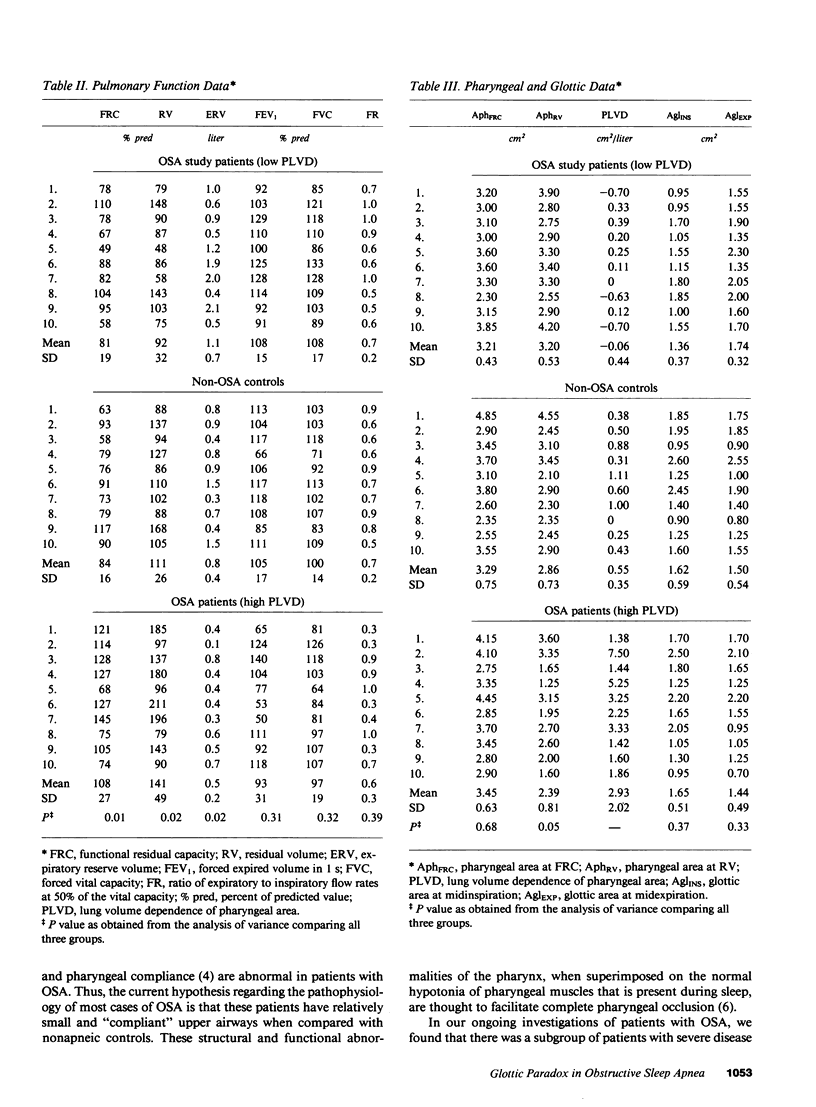Abstract
Most patients with obstructive sleep apnea have increased pharyngeal collapsibility (defined in the present study as an increased lung volume dependence of pharyngeal area), which predisposes them to upper airway occlusion during sleep. However, there are patients with severe obstructive sleep apnea who have low-normal pharyngeal collapsibility. The factors leading to nocturnal upper airway obstruction in such patients have not been ascertained. We studied 10 overweight male patients with severe obstructive sleep apnea and low-normal pharyngeal collapsibility to determine the site of upper airway pathology in these patients. We found that all 10 patients exhibited paradoxical inspiratory narrowing of the glottis during quiet tidal breathing. This phenomenon was not observed in a matched group of 10 snoring, nonapneic male controls. We conclude that paradoxical glottic narrowing may be a contributing factor in the pathogenesis of upper airway obstruction in patients with severe obstructive sleep apnea who have low-normal pharyngeal collapsibility.
Full text
PDF




Selected References
These references are in PubMed. This may not be the complete list of references from this article.
- Anch A. M., Remmers J. E., Bunce H., 3rd Supraglottic airway resistance in normal subjects and patients with occlusive sleep apnea. J Appl Physiol Respir Environ Exerc Physiol. 1982 Nov;53(5):1158–1163. doi: 10.1152/jappl.1982.53.5.1158. [DOI] [PubMed] [Google Scholar]
- Bartlett D., Jr, Remmers J. E., Gautier H. Laryngeal regulation of respiratory airflow. Respir Physiol. 1973 Jul;18(2):194–204. doi: 10.1016/0034-5687(73)90050-9. [DOI] [PubMed] [Google Scholar]
- Bradley T. D., Brown I. G., Grossman R. F., Zamel N., Martinez D., Phillipson E. A., Hoffstein V. Pharyngeal size in snorers, nonsnorers, and patients with obstructive sleep apnea. N Engl J Med. 1986 Nov 20;315(21):1327–1331. doi: 10.1056/NEJM198611203152105. [DOI] [PubMed] [Google Scholar]
- Brown I. B., McClean P. A., Boucher R., Zamel N., Hoffstein V. Changes in pharyngeal cross-sectional area with posture and application of continuous positive airway pressure in patients with obstructive sleep apnea. Am Rev Respir Dis. 1987 Sep;136(3):628–632. doi: 10.1164/ajrccm/136.3.628. [DOI] [PubMed] [Google Scholar]
- Brown I. G., Bradley T. D., Phillipson E. A., Zamel N., Hoffstein V. Pharyngeal compliance in snoring subjects with and without obstructive sleep apnea. Am Rev Respir Dis. 1985 Aug;132(2):211–215. doi: 10.1164/arrd.1985.132.2.211. [DOI] [PubMed] [Google Scholar]
- Christopher K. L., Wood R. P., 2nd, Eckert R. C., Blager F. B., Raney R. A., Souhrada J. F. Vocal-cord dysfunction presenting as asthma. N Engl J Med. 1983 Jun 30;308(26):1566–1570. doi: 10.1056/NEJM198306303082605. [DOI] [PubMed] [Google Scholar]
- Collett P. W., Brancatisano T., Engel L. A. Changes in the glottic aperture during bronchial asthma. Am Rev Respir Dis. 1983 Oct;128(4):719–723. doi: 10.1164/arrd.1983.128.4.719. [DOI] [PubMed] [Google Scholar]
- Conway W., Fujita S., Zorick F., Sicklesteel J., Roehrs T., Wittig R., Roth T. Uvulopalatopharyngoplasty. One-year followup. Chest. 1985 Sep;88(3):385–387. doi: 10.1378/chest.88.3.385. [DOI] [PubMed] [Google Scholar]
- D'Urzo A. D., Lawson V. G., Vassal K. P., Rebuck A. S., Slutsky A. S., Hoffstein V. Airway area by acoustic response measurements and computerized tomography. Am Rev Respir Dis. 1987 Feb;135(2):392–395. doi: 10.1164/arrd.1987.135.2.392. [DOI] [PubMed] [Google Scholar]
- D'Urzo A. D., Rubinstein I., Lawson V. G., Vassal K. P., Rebuck A. S., Slutsky A. S., Hoffstein V. Comparison of glottic areas measured by acoustic reflections vs. computerized tomography. J Appl Physiol (1985) 1988 Jan;64(1):367–370. doi: 10.1152/jappl.1988.64.1.367. [DOI] [PubMed] [Google Scholar]
- Fouke J. M., Strohl K. P. Effect of position and lung volume on upper airway geometry. J Appl Physiol (1985) 1987 Jul;63(1):375–380. doi: 10.1152/jappl.1987.63.1.375. [DOI] [PubMed] [Google Scholar]
- Fredberg J. J., Wohl M. E., Glass G. M., Dorkin H. L. Airway area by acoustic reflections measured at the mouth. J Appl Physiol Respir Environ Exerc Physiol. 1980 May;48(5):749–758. doi: 10.1152/jappl.1980.48.5.749. [DOI] [PubMed] [Google Scholar]
- Haponik E. F., Smith P. L., Bohlman M. E., Allen R. P., Goldman S. M., Bleecker E. R. Computerized tomography in obstructive sleep apnea. Correlation of airway size with physiology during sleep and wakefulness. Am Rev Respir Dis. 1983 Feb;127(2):221–226. doi: 10.1164/arrd.1983.127.2.221. [DOI] [PubMed] [Google Scholar]
- Issa F. G., Sullivan C. E. Upper airway closing pressures in obstructive sleep apnea. J Appl Physiol Respir Environ Exerc Physiol. 1984 Aug;57(2):520–527. doi: 10.1152/jappl.1984.57.2.520. [DOI] [PubMed] [Google Scholar]
- Issa F. G., Sullivan C. E. Upper airway closing pressures in snorers. J Appl Physiol Respir Environ Exerc Physiol. 1984 Aug;57(2):528–535. doi: 10.1152/jappl.1984.57.2.528. [DOI] [PubMed] [Google Scholar]
- Jackson A. C., Olson D. E. Comparison of direct and acoustical area measurements in physical models of human central airways. J Appl Physiol Respir Environ Exerc Physiol. 1980 May;48(5):896–902. doi: 10.1152/jappl.1980.48.5.896. [DOI] [PubMed] [Google Scholar]
- Orem J., Norris P., Lydic R. Laryngeal abductor activity during sleep. Chest. 1978 Feb;73(2 Suppl):300–301. doi: 10.1378/chest.73.2_supplement.300. [DOI] [PubMed] [Google Scholar]
- Rivlin J., Hoffstein V., Kalbfleisch J., McNicholas W., Zamel N., Bryan A. C. Upper airway morphology in patients with idiopathic obstructive sleep apnea. Am Rev Respir Dis. 1984 Mar;129(3):355–360. doi: 10.1164/arrd.1984.129.3.355. [DOI] [PubMed] [Google Scholar]
- Sherrey J. H., Megirian D. Respiratory EMG activity of the posterior cricoarytenoid, cricothyroid and diaphragm muscles during sleep. Respir Physiol. 1980 Mar;39(3):355–365. doi: 10.1016/0034-5687(80)90066-3. [DOI] [PubMed] [Google Scholar]
- Stauffer J. L., Zwillich C. W., Cadieux R. J., Bixler E. O., Kales A., Varano L. A., White D. P. Pharyngeal size and resistance in obstructive sleep apnea. Am Rev Respir Dis. 1987 Sep;136(3):623–627. doi: 10.1164/ajrccm/136.3.623. [DOI] [PubMed] [Google Scholar]
- Suratt P. M., Dee P., Atkinson R. L., Armstrong P., Wilhoit S. C. Fluoroscopic and computed tomographic features of the pharyngeal airway in obstructive sleep apnea. Am Rev Respir Dis. 1983 Apr;127(4):487–492. doi: 10.1164/arrd.1983.127.4.487. [DOI] [PubMed] [Google Scholar]
- Wilms D., Popovich J., Conway W., Fujita S., Zorick F. Anatomic abnormalities in obstructive sleep apnea. Ann Otol Rhinol Laryngol. 1982 Nov-Dec;91(6 Pt 1):595–596. doi: 10.1177/000348948209100612. [DOI] [PubMed] [Google Scholar]
- van Lunteren E., Strohl K. P., Parker D. M., Bruce E. N., Van de Graaff W. B., Cherniack N. S. Phasic volume-related feedback on upper airway muscle activity. J Appl Physiol Respir Environ Exerc Physiol. 1984 Mar;56(3):730–736. doi: 10.1152/jappl.1984.56.3.730. [DOI] [PubMed] [Google Scholar]


